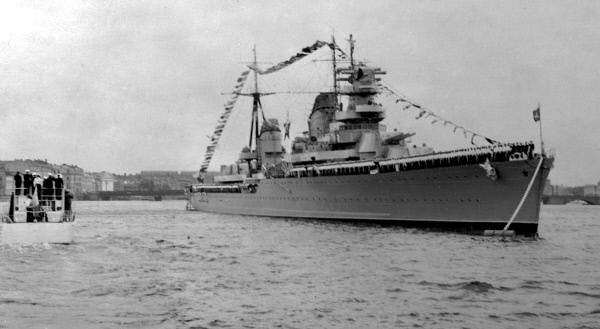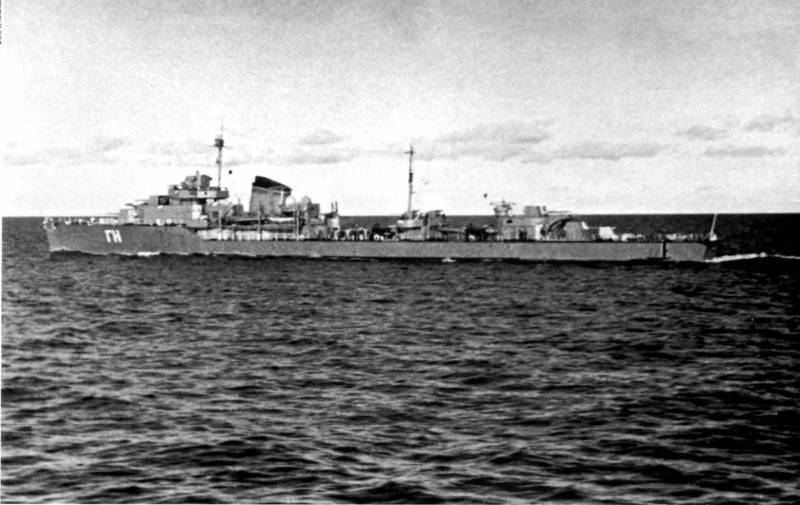Destruction of the destroyer "Wrathful"
Destroyer "Angry" was the lead ship in the generally successful series of Project 7, built in 1936-1938. With a displacement of 1670 tons, it carried strong artillery, torpedo and anti-submarine weapons. The main caliber artillery consisted of four 130 mm B-13-I guns. It was supplemented by two universal guns of 76 mm caliber of the 34-K type, two semi-automatic anti-aircraft guns 45 mm of the 21-K type and two anti-aircraft machine guns DShK. Torpedo armament consisted of two three-tube torpedo tubes 533 mm type 39-Yu. To combat enemy submarines, the destroyer carried 25 depth charges and could take on board 60–65 mines.
Carrying out the assigned task, the detachment of light forces maneuvered west of the destroyer group, north of the island of Hiiumaa, approximately abeam Cape Tahkuna. To protect against enemy mines, the ships deployed paravan trawls, and to protect against a sudden torpedo attack by German submarines, they went on a variable course in anti-submarine formation. The lead ship was "Angry"... Behind him, at a distance of 8 cables, walked "Maksim Gorky" с "Proud" и "Guarding" along the sides.
And it was when the ships went in such a formation, at 3:40, under the nose "Angry" a violent explosion thundered. It turned out that the ships entered the barrage Apoldadelivered the previous night by the German ships of the group "North"... Paravan did not protect "Angry"... Quite the opposite - apparently, the destroyer struck the mine with its bow before the paravan had time to pull it aside. The consequences of the explosion were terrible: the explosion tore off the nose "Angry" on the very bridge.
Water poured into the hole and flooded the third living deck and the first boiler room. The destroyer was left without lighting and movement. 20 sailors were killed and 23 were wounded. The crew immediately began to fight for the unsinkability of the ship and "Angry" kept buoyant. After applying the plasters, after 15–20 minutes, the water flow stopped. Water pumping began with a motor pump and "Angry" took a stable position with a slight roll to the port side. The ship tried to raise steam in the third boiler. But at this time, the observers allegedly found submarine periscopes around the ship, although they could not be on the minefield. Nevertheless, the squadron commander panicked and ordered the transfer of the crew. "Angry" to the destroyer "Proud", flood the damaged ship, and then proceed to Tallinn. The order was carried out, however "Angry" did not want to drown in any way - only two days later he was discovered and finished off by a German aviation... But the problems did not end there.

Cruiser "Maxim Gorky"
The commanders quickly realized that their squad had stumbled upon a minefield, and leaving it required very careful maneuvering. In a critical situation, the commander "Maxim Gorky", captain of the second rank Anatoly Petrov, kept his composure and immediately after the "Angry" ordered to stop the vehicles on the cruiser, and then at full speed back to prevent a collision with the damaged destroyer. Further, the cruiser at a slow speed back began to leave the dangerous area.
I did the same "Guarding"... Soon, both ships turned on a countercourse, in the direction of the Moonsund Strait, trying to quickly leave the mined waters. It seemed that the danger had already passed when at 4:22 am on the mines Apolda IV blown up "Maksim Gorky"... The damage was no less serious than on "Angry".
"Maksim Gorky" also lost his nose, which sank. And only thanks to the sturdy structure of the hull and bulkheads the cruiser remained afloat. Destroyer coming to his aid "Guarding" was also damaged by the explosion of two pounded mines on the fence "Gotha"... Fortunately, they were insignificant - only the trawl paravan was destroyed. "Guarding" even managed to tow the damaged cruiser to a safe place off the western coast of the island of Vormsi, from where "Maksim Gorky" already on its own, accompanied by torpedo boats and minesweepers, reached Tallinn, and then to Kronstadt and Leningrad.
Finally, the "Proud" was also damaged by mines, although not as severe as "Angry"... On my course "Proud" twice encountered mines, which, during trawling, exploded at a considerable distance and caused only minor damage to the destroyer's hull.
The scrapes in which the detachment of light forces fell, did not, however, affect the operation of the mining group, which quickly and without loss completed the assigned task. The laying of minefields continued in the following days, already under the cover of the cruiser Kirov and destroyers. Moreover, the largest number of mines was placed by the mine. "Marty" under the command of Captain First Rank Nikolai Meshchersky. The cruiser itself Kirov On June 30 - in view of the threat to the Ust-Dvinsk base from land - he was sent to Tallinn, where he arrived, having made a difficult and dangerous passage through the shallow Moonsund Strait.
Worse, the loss of a modern destroyer and heavy damage to the cruiser on the night of June 22-23 further weakened the defenses of the Moonsund Islands. Light damage "Proud" и "Guarding" also did not set up optimistically. The Soviet command realized that the Germans were ahead of the Soviet Union in deploying minefields, and on the night before their attack on the USSR, they managed to create a serious threat to the Soviet naval forces in the Gulf of Finland and in the area of the Moonsund Islands. The threat was all the greater because the Baltic Fleet did not have a sufficient number of minesweepers to eliminate it, and what is worse, did not have the means to combat non-contact magnetic and bottom mines.
Therefore, the commander-in-chief of the Baltic fleet Vice-Admiral Vladimir Tributs already on the second day of the war sent the People's Commissar of the Navy, Admiral Nikolai Kuznetsov, an alarming report about the mine danger and the real threat to paralyze the operations of the fleet. The acuteness of the question forced him to suggest “picking up everything in Leningrad that might be suitable” for sweeping mines, and if this is not possible, then “picking up 15–20 sea or river tugs, up to wheeled ones”.
The proposal was approved. And the anti-mine forces of the Baltic began to be replenished with various vessels of the civil and fishing fleet, adapted to sweep mines or conduct reconnaissance of a mine situation. Due to this, by the beginning of July 1941, the level of mine danger had significantly decreased.
Sources and literature:
S. Balakin. Legendary "sevens": destroyers of the "Stalinist" series... Eksmo, 2007.
N.G. Kuznetsov. Heading towards victory... Military Publishing, 1976.

Information